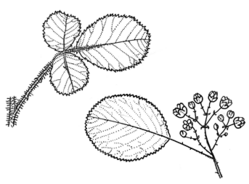Common name: Yellow Raspberry
Rubus ellipticus Sm. APNI* 
Description: Arching or climbing shrub. Primocane stems rounded or round-angled, densely covered with 2–3 mm long reddish-brown bristles over sparse to dense non-glandular pilose hairs, prickles 2–5 mm long, often obscured by bristles, not confined to angles. Flowering stems from the leaf axils of the floricane.
Primocane leaves consisting of 3 leaflets; mature mid primocane leaflets densely felted below pilose hairs, terminal leaflet usually largest, obovate to nearly orbicular, mostly 2–7 cm long and 1.6–6 cm wide, petiole 2.5–5 cm long. Floricane leaves at base of flowering panicles consisting of 3 leaflets, lower surface of leaflets as for mid primocane leaflets, mostly 1.7–7.5 cm long and 1.7–6 cm wide, petiole 1.5–5.5 cm long.
Inflorescence a dense panicle terminal on stems arising in the leaf axils of 3-leaflet leaves. Sepals without prickles. Petals 7–10 mm long, 5–8 mm wide, elliptic to obovate, white, crumpled. Stamens shorter than styles.
Fruit ovoid to oblong, initially green, ripening yellow.
Flowering: mainly spring and summer.
Distribution and occurrence: not common. Native of Asia and Malesia. Found in grasslands to forests in coastal areas.
NSW subdivisions: *NC, *CC
Other Australian states: *Qld
Distinguished by its rounded leaflets, stems covered by reddish-brown bristles and fruit that ripen yellow. Introduced for its edible fruit.
Text by John Hosking, June 2009
Taxon concept: Evans et al., Australian Systematic Botany 20: 187-251 (2007); Harden & Rodd (1990) Flora of NSW 1.
APNI* Provides a link to the Australian Plant Name Index (hosted by the Australian National Botanic Gardens) for comprehensive bibliographic data
***The AVH map option provides a detailed interactive Australia wide distribution map drawn from collections held by all major Australian herbaria participating in the Australian Virtual Herbarium project.
|


